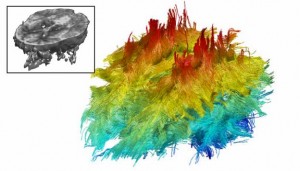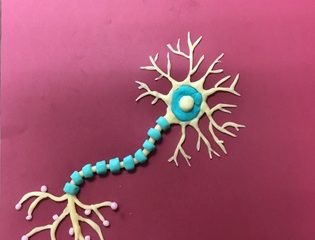As my students and readers are aware, my only dabbling with personal biochemistry is limited to consuming substantial amounts of caffeine. Consequently, I was more than a little taken aback when my students, via their anonymous iClickers, informed me that 60% of them had consumed enough alcohol that they barfed. According to my reading, vomiting normally begins to occur when blood alcohol (BAC) is in the .12 to .15 range. Granted, this is not the same as the life-threatening levels of BAC (.37 or higher), but it certainly is more than legally drunk.
Adolescents, and in brain development terms that includes people into their early 20s, have reason to be a bit more cautious about alcohol. Susan F. Tapert of UC San Diego and her colleagues used diffusion tensor imaging (DTI) to image white matter [1]. Teens with a history of binge drinking episodes (four or more drinks on one occasion for females and five for males) showed lower coherence of white matter in several brain regions. None of the teens qualified for a clinical diagnosis of “problem drinkers.” White matter coherence correlates with the outcomes of numerous cognitive tests, and compromised white matter affects the ability to consider multiple sources of information during decision-making and emotional functioning.

Diffusion Tensor Imaging of the Brain's White Matter
I share with many of my colleagues in higher education a growing concern about the amount of drinking that occurs on campus. Many of our students are arriving on campus as freshmen with binge drinking as an established habit. Perhaps an understanding of the impact of binge drinking on cognitive development will convince some to rethink this behavior.
1. Bava S, Frank LR, McQueeny T, Schweinsburg BC, Schweinsburg AD, & Tapert SF (in press). Altered white matter microstructure in adolescent substance users. Psychiatry Research: Neuroimaging.



14 Comments
steelersfan086 · April 24, 2009 at 10:56 am
I found this post extremely intriguing. I know that I, at least, never even thought about alcohol’s effects on the brain. I usually think about the more common effects, or well-known effects, such as liver damage, impaired judgment, and so on. I never connected the dots to realize that impaired judgment originates in the brain, as well as decision-making. I know it seems obvious but it is more common to think about the immediate effects instead of what is actually going on in our brains. This definitely makes me think more about the consequences of heavy drinking.
shaunashea · April 28, 2009 at 2:10 pm
I am actually surprised your i-clicker response was so high at Cal Poly. As stated above, I have never thought twice about alcohol’s effects on the brain either. It is much more obvious to me to consider effects on the liver and kidneys. When thinking of extended brain damage, I generally think of other drugs (MDMA as an example).
I also did not know the level at which it is typical for a person to throw up. This was very informative and eye-opening as well.
Jenniferdonnelly · April 28, 2009 at 3:20 pm
Honestly, I’m not very surprised that there results were so high. I commonly hear people talking about how much they threw up the night before, or similiar stories. I don’t think many people see it as a bad thing, and that it is more seen as a common occurence. I find this infor very interesting, though, because I don’t think these effects are shown to college students. When I think of problems with alcohol, I think of alcoholics, not college parties. I think it would be worthwhile to get more info like this out there so that people are more aware.
jeffcurry · April 28, 2009 at 8:59 pm
The availability of alcohol to incoming freshman is certainly a problem. During WOW week it is almost guaranteed that if you are attending a party you are going to get a drink. Many simply classify this as the “college life” but is it the life we as college students attempting to become the leaders of the new world should be living? The decrease in white matter astonished me. I knew alcohol impaired the brain but had no idea of the effects afterward. Unfortunately, I do not think much can be done about college kids drinking alcohol. I also believe that because alcohol is prohibited to minors, it entices them to drink more as if to say “I can handle it”.
SamanthaKapheim · April 29, 2009 at 9:34 am
While awareness of the drinking problems at Cal Poly is needed I don’t feel that many students take them seriously. I used to always see signs on campus for Cal Poly’s “Under Four” campaign, which was designed for educating students about the dangers of binge drinking and correcting the misconception that most students drank over four drinks per sitting. While this was informative, most students I knew laughed them off or simply ignored them. While I have no problem going out for a drink with friends, I get very worried when I have friends who say “I just want to get drunk tonight”. This type of negative behavior will not get them far in life.
Laura Freberg · April 29, 2009 at 4:26 pm
I admit I was shocked when I saw my first “under four” poster, like “only” having four drinks was moderate drinking….I just can’t imagine drinking anything close to that. I’m very concerned about the way alcohol is marketed to youth. The Restaurant and Bar Owners Association threatened to boycott General Motors a few years ago for making a donation to Mothers Against Drunk Driving. How can you be against drunk driving?
http://www.alcoholrehabcenter.com/content/7528/gm-madd-targeted-by-alcohol-industry.php
jacquelynlaing · May 11, 2009 at 1:00 pm
I think that binge drinking is a huge problem at poly because it is seen as a normal thing to do. I can’t even count how many times I heard “I want to black out tonight.” or “Lets get wasted” since coming to college. I think that if students knew the effects that binge drinking had on them, they would be less likely to participate in such behaviors.
Sierrasmargon · May 11, 2009 at 8:52 pm
I know that binge drinking in college has been a part of American culture for a while, but I know there will be more and more studies coming out on the long term effects of drinking to the point where you puke almost every weekend. I wonder all the time.. “How many of us are going to have liver problems?” and…”How many of us will not be able to stop binge-drinking once we leave college?” Also as alchohol is a depressant and decreases your release of serotonin levels..is depression becoming more widespread in our generation as binge drink popularity is rising??
grubino · May 13, 2009 at 9:26 am
Reading this article was a bit scary for me. Many are aware, including myself, the effects alchohol can have on the body; most commonly known are the liver and kidneys, as well as the detrimental effects it can have on a developing fetus’s nervous system. But the additional detrimental effects it can have on our developing brains even in our teens to early twenties is scarier, especially since high school and college students don’t consider binge drinking a dangerous issue. Our generation has accepted binge drinking as socially acceptable, and thus studies like this need to be addressed so students are more aware of the long term effects alcohol can have on us even if we are only “abusing” for an x amount of years.
JoeGaldamez · May 13, 2009 at 2:23 pm
I knew it! I always wondered what alcohol was doing to our brains, other than inhibiting regions of the frontal lobe with the ensuing statement, “Oh, that happened because I was drunk.” Also, alcohol loves the cerebellum–its victim–and will most definitely shut it down, which explains our stumbling, our loss of pain, and many many more not-so-smart choices throughout the wild night. But now there’s more! Now the impact alcohol has on our brain development! Just imagine how this might compromise our wonderful cognitive abilities in the future–to think, to learn, to feel. This has given me a whole new perspective in drinking. Drinking a couple of drinks and socializing is great, but drinking till we hit the floor–not so good, and this blog proves that. I WILL share this.
averyzaninovich · May 26, 2009 at 2:01 pm
I am training to be a WOW leader for this coming fall. I can’t begin to count the times we have been strongly encouraged, almost to the point of begging, to inform our freshman on the effects of binge drinking. We have even been told many times that the SLO police are cracking down heavily this year and will not be giving warnings. They want to make sure freshman are safe and start the year the right way, or even start the eyar at all for that matter. Drinking heavily in college is part of our culture and talking to college graduates almost always guarantees hearing some story about a time they were drunk with their college buddies. When I was a freshman during wow week, my roommate, friends and I went to hathway every night to drink and get wasted. Then after that week, we didn’t want it to stop and continued to find any party where we could get alcohol, any night of the week. Looking back, I do regret it because I will never forget how I began my time at Cal Poly. Instead of finding ways to become involved in activities that made a positive impact on the community, I found ways to make a negative impact on my body. My group of freshman will be well informed on the effects of binge drinking, and I hope they will make the right decision for themselves and not wander down hathway during wow week.
Kenneth · May 26, 2009 at 9:48 pm
Well alcohol in the end is a poison. I am not to sure how many people actually realize that it will catch up with them when they are under aged. Its also a bit ridiculous how available it is to us. Free at many times with so many people already doing it, it is pretty tempting.
Alcohol and Obesity | Laura’s Psychology Blog · June 18, 2009 at 8:10 pm
[…] aside the obvious health risks from this behavior, including a disruption of white matter development, it occurred to me that all of this drinking might have something to do with our current obesity […]
Laura’s Psychology Blog » Binge Drinking and Back to School · September 17, 2009 at 1:12 pm
[…] that alcohol advertising (in excess of $4 billion per year) drowns out the cautionary messages. In a previous post, I talked about diffusion tensor imaging results that showed that teenage binge drinking had […]
Comments are closed.